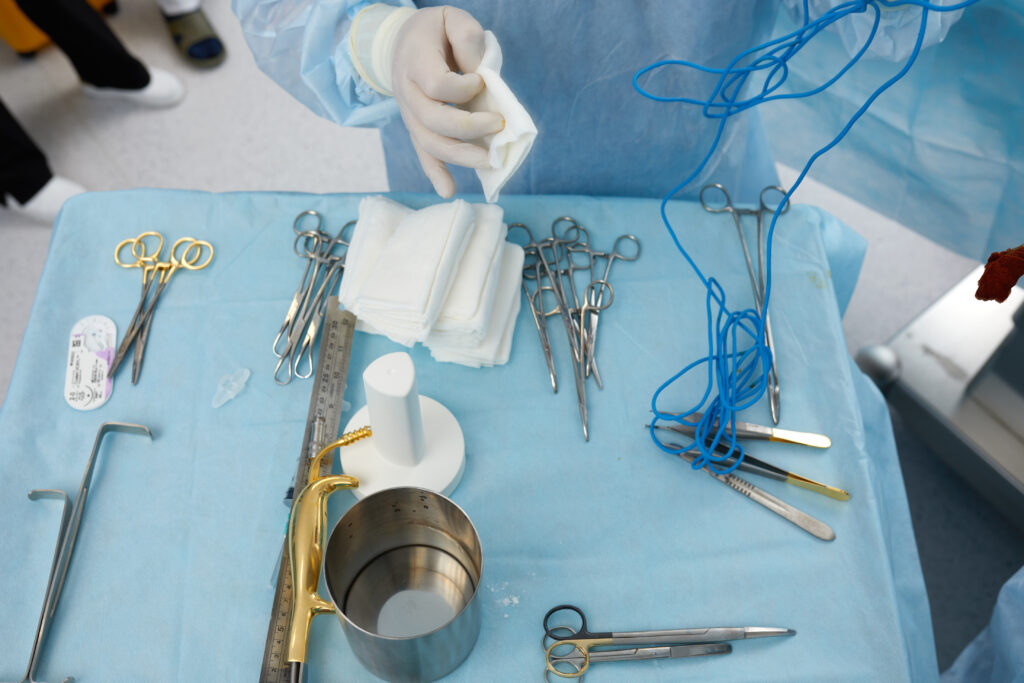Meta Description:
“Is robotic surgery better than traditional surgery? Delve into the advantages, the in-depth analysis, and real examples. No one has found out the benefits of robotic surgery and how such treatments revolutionize medicine!”
Introduction:
Is Robotic Surgery Better Than Traditional Surgery? With the remarkable capacity of medical technology in the contemporary era, such a question has become one of the many questions that many would like to ask regarding today’s surgeries. As robotic-assisted operations flourish, many people ask themselves the question – Are there any clear benefits of those types of operations compared to the traditional surgical techniques?

To be honest with you, the risks of traditional surgery made me think of other ways of treatment. That’s when I saw that Robotic Surgery might prove to be a safer and more precise method.
Problem: Traditional Surgery Comes with Risks and Limitations
For years, conventional surgery has remained the most-used method in treatment of patients. It also has its drawbacks, which include:
- Invasive Procedures: Conventional open surgery practice entails wide surgical cuts, considerable external scarring, and protracted recovery periods.
- High Susceptibility to Mistakes: The surgeons depend solely on their surgical expertise and skills which predisposes them to excessive mistakes in challenging tasks such as surgery.
- Longer Recovery Time: In most cases, traditional invasive operations necessitate a greater degree of recovery and home or social rehabilitation.
- Lower Accuracy Levels: Navigating through small areas or delicate tissues is difficult which may affect results.
These problems have necessitated the search for other treatment alternatives within the medical industry thus the emergence of robotic aided surgery.
The first time I heard about robot assisted surgery, I was wondering what its advantage was over the normal surgery. But after being told about its accuracy, I understood why it was becoming more popular.
Agitate: Understanding the Shortcomings of Traditional Methods
Surgery involves a lot of complicated procedures that make many people think about them and large cuts, long healing periods and risks of failure. These problems are not just annoying; they can increase expenses, lead to more pain after the operation and also make the person take longer sick leaves from work. Nevertheless, surgeons do their utmost in order to avoid risks; in most cases, traditional surgeries are more invasive, and that comes at greater expense of the physiological capacity of the body.
Here are a few limitations of conventional surgery:
- Pain and Discomfort Post-Operation: Greater incisions tend to inflict more pain and even discomfort when recovering.
- Extended Recovery Period: Using more invasive techniques with wider cuts, physical healing can take several weeks or even months.
- Increased Risk of Contamination: The more significant the cut, the invasion gives a higher probability of contamination which may bring about complications.
As an alternative, robotic surgery has come as a solution to these issues in a more efficient way since it is less invasive.
I find the fast recovery period after the surgery to be one of the greatest advantages of the robotic surgical procedure. This is because I understand how hard it is to recuperate after a bigger surgery, so this advantage impresses me so much.
Solution: Robotic Surgery Offers Greater Precision, Safety, and Efficiency.
In other words, robotic surgery is the use of robotic systems for surgery, enabling the performance of those activities that could be performed through a conventional method but with improved precision, flexibility and control. The surgeon operates from a console using robotic arms constructed in a way that any motion of the hands is converted into motion but to a very small component.
1. Enhanced Precision
- Smaller Cut Sizes:
Most surgeries today involve minimal incisions hence less damage to tissues.
- Greater Control:
Movement within robotic systems has been enhanced and allows very fine movements to be performed more accurately.
- Better Images:
The picture is brought even closer to the surgeons thanks to the use of 3D HD cameras.
Case Study:
According to a publication in the Journal of Surgical Oncology, there are fewer complications associated with robotic colorectal surgery compared to traditional surgery due to increased accuracy and precision use.
2. Reduced Risk of Human Error
- Keeping Still:
Most of the robotic systems allow really fine control without any hand shaking at all.
- Some surgical robots perform three-dimensional vision for suturing or cutting to minimize inaccuracy.
Case Study:
Those undergoing prostate cancer surgery via a robot assistance had lower postoperative complication rates than the conventional surgical technique as per a study published in The Lancet.
3. Faster Recovery Time
- Minimally Invasive:
Less damage to tissue gives rise to fast healing and shorter confinements in the hospital.
Case Study:
Robotic-assisted surgery for hernia was associated with a 25% reduction in recovery time compared to conventional techniques as published in JAMA Surgery.
4. Less Post-Operative Pain
- Less Traumatization:
Lesser incision areas creates less pain and reduces the reliance on painkillers.
Case Study:
The procedures that were adopted by Patients in The American Journal of Surgery showed lower pain levels in patients after robotic arm-assisted laparoscopic cholecystectomy than traditional cholecystectomy.
5. Lower Risk of Infection
- Decreased Incisions:
Lesser incisions makes it less possible for any infection to occur.
Case Study:
The review found in Annals of Surgery also reported that infections in robotic-assisted gynecological surgeries were lower than that of the conventional open-surgery techniques.
6. Improved Surgeon Ergonomics
- Less Fatigue:
Surgeons can sit comfortably and maintain better posture during long procedures.
Case Study:
A study in The BMJ found that robotic surgeries resulted in less fatigue for surgeons, improving their overall performance.
7. Higher Patient Satisfaction

- Improved Results:
Robotic surgery has been associated with a lower incidence of postoperative complications, less pain, and faster return to baseline physical status.
- Aesthetic Advantages:
Patients find it very encouraging to undergo less invasive surgical procedures that produce smaller scars.
Case Study:
- In a survey by the American College of Surgeons, patients who had robotic surgery reported greater satisfaction than those who had traditional surgery.
Can You Provide More Examples of Specific Procedures Where Robotics Excel?
- Prostatectomy:
Performing robotic prostatectomy affords the surgeon a high degree of dexterity, facilitating the removal of the prostate.
- Hysterectomy:
Used in most gynecological procedures such as removal of the womb (hysterectomy).
- Colorectal Surgery:
Robotic devices are of assistance in challenging surgeries of the colon and rectum.
- Heart Surgery:
Robotic technology is increasingly used in the repair of heart valves.
- Joint Replacement:
Robotics enhance the precision of knee and hip replacement.
How Can Patients Prepare for a Robotic-Assisted Surgery?Is Robotic Surgery Better Than Traditional Surgery ?
- Medical Evaluation:
This means ensuring that you have done all pre-surgical screening and consultations.
- Follow Doctor’s Instructions:
This means observing any diet or medication restrictions prior to the operation.
- Stop Smoking:
Stopping tobacco use can encourage faster recovery and lessen complications of the operation.
- Arrange Support:
Ensure that you have someone to assist you in the process of healing at your house after the surgery.
- Stay Hydrated:
Leading up to the surgery, make sure to take lots of water healthy.
What Are the Potential Risks of Robotic-Assisted Surgery?

- Technical malfunctions:
Once the procedure has started, the robotic system may malfunction.
- Infection:
Even though it is less common, there is still a chance of infection when undergoing surgery.
- Bleeding:
Patients are at risk of suffering from internal bleeding like any other conventional surgery.
- Nerve Damage:
This is very rare, though it is a possibility depending on the procedure undertaken.
- Anesthesia Related Complications:
General anesthetics have their risks and complications including reactions.
How Long Does Recovery Typically Take After a Robotic Procedure? Is Robotic Surgery Better Than Traditional Surgery ?
- Shorter Hospital Stay:
Majority of the patients are discharged in 1-2 days.
- Return to Work:
Many patients engage in light work within 1-2 weeks after the surgery.
- Full Recovery:
Minor surgeries can take about 3-4 weeks for complete recovery.
- Faster Healing:
There are smaller incisions for a quicker recovery than traditional techniques.
- Follow-Up:
You will also be scheduled for the doctor’s appointments to monitor your healing.
Can You Provide Tips for Managing Postoperative Pain?
- Take the Medications Prescribed:
Diasporadical control pain as per the prescription.
- Apply Cold Packs:
Reduce inflammation and pain by using ice packs.
- Keep Moving:
Take light walks to encourage blood flow and facilitate healing.
- Use Pillows for Support:
Place pillows to the affected areas in order to remove excess weight.
- Talk to Someone:
Speak to the physician in the event that the pain becomes intolerable.
What Are Some Common Postoperative Complications After Robotic Surgery?

- Infection:
Often superficial, infections may still result in eventual healing at the incision site.
- Bleeding:
May be internal or external and may need management.
- Incisional Hernia:
Incisional hernia forms at the incision sites.
- Nerve Injury:
Some cases might come with nerve damage.
- Keloid formation:
Keloids have however been kept to a minimum but still will be present.
How Can Patients Manage Pain During the Recovery Period?
- Comply with Pain Management Plan:
Adhere to the recommendation and instructions of the physician.
- Rest:
Make sure that there is time for the aching body to recuperate.
- Hydrate:
Water is essential to cleanse out harmful substances from the body and also maintain good health.
- Gentle Movement:
Engage in some movement to avoid being stiff.
- Over The Counter Medications:
Follow the directions given for moderate pain relief.
Are There Any Specific Dietary Recommendations for a Faster Recovery?
- Protein Containing Food:
Protein is essential in rebuilding the body’s tissues after the surgical operation.
- Stay Hydrated:
Consume a lot of water and other fluids as well to facilitate the healing process.
- Consume More Fiber In Your Meals:
It helps to prevent constipation after the surgical operation.
- Eat More but Small Most of The Time:
Choose less bulky meals that can be easily accommodated.
- Do Not Overindulge in Sweets:
Too sugary diets promote inflammation within the body.

Conclusion: Is Robotic Surgery Better Than Traditional Surgery ?
There is no doubt that traditional surgery has its advantages; however the numerous advantages of robotic surgery makes it appealing to many patients and surgeons. From improved accuracy and lower chances of complications to less time spent recuperating and happier patients, robotic surgery overcomes many of the shortfalls of conventional methods.
Nonetheless, it should be pointed out that robotic surgery is not applicable on every patient or condition. A decent surgeon must be sought to evaluate the particular case. As the ages of the world go along, we are positive that the trend of robotic surgery will keep increasing within many sectors of medicine.
Final Thoughts:
Robotic surgery is changing the pace of medical practice, but like any other technology, its advantages and disadvantages should be considered. Conventional surgery continues to work well for many procedures, but the advantages of robotic surgery are such that they enhance patient care.

